|
Hot Rod Nitro FireBall
Click on any picture to enlarge |
Flown on 9 to 18
engines and launched 6 second stage rockets in flight
Team project by Boris
Katan and David Mackiernan
7 feet tall by 4 inches diameter. Flight weight 14 pounds.
|
|
Remastered Video:
flights 1 & 2:
including Amazing Onboard Video - 18 engines fired, 2 stages, 7 rockets at
LDRS 28! |
flight 4 - Last flight: 10/2/10 CMASS Amesbury, MA
Stage 1 - main rocket: 1x H-399 + 3x F45 RR + 3x D11-P /
Stage 2 - 6x Nitros: 6x D12-5
Last HRNF flight, stage 1 main rocket
lifted off and deployed its chutes well.
Unfortunately, the 6x stage 2 Nitros ignited but did not separate and burned
the ring of fire
badly. This project has been retired.
|
|
flight 3: 9/19/09 CMASS Amesbury, MA
Stage 1 - main rocket: 1x
Pro-X H255 Blue + 12x D11-P
Stage 2 - 6x Nitros: 6x D12-5
The flight was a fun one, on a clear and windy day.
My son Paul showing the business end of stage 1.
David, Alan and I up to no good at the pad.
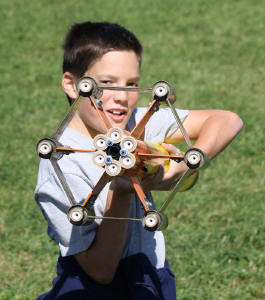
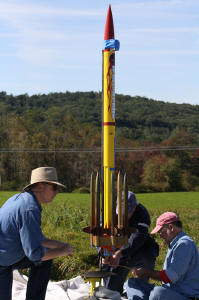
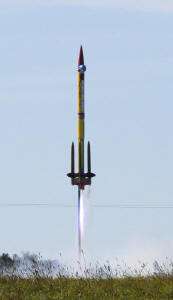
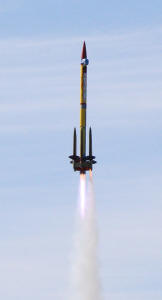
The H255 fires quickly, only half the D11s are ignited.
Ignition of the 6x second stage Nitros is exciting and mostly successful. 5
are fired and 4 fly upwards
Recovery of central rocket is good, using deployment bag and 7' chute.



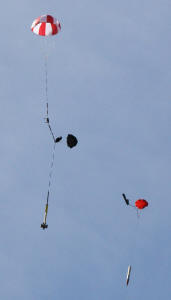
The Nitros quickly filled the sky, shooting off in all directions. One even
headed straight down and pranged under power.
It may have been bumped, turbulence and wind were big factors too. This
Nitro was the only thing damaged in the flight.
Main rocket only went up 448ft, due to a few engines not fired, weather
cocking, and planned moderate impulse. Thrust at the pad was reduced 18% due
to stage 1 motors not fired.
The Nitro's ematches were held in place with Estes igniter plugs, usually I
use tape. The plugs worked well for 5 of the Nitros, but one ematch was
damaged by jamming in the plug, and that's the Nitro that stayed with the
main rocket all the way back to the ground.
Unfortunately, the onboard video camera shut off before the flight took off.
Pre-Flight Planning:
Prepped similarly to the way it was at LDRS for flight 2, except:
1) Less thrust on the main rocket. About 2/3 of LDRS flight, resulting in
reduced acceleration and wind speed that the Nitros have to deal with 0.6
seconds into flight when they are ignited.
2) Stage 2 Nitros are slightly more snugly mounted to the stage 1 main
rocket. |
|
flight 2: 7/3/09 LDRS 28 Potter, NY
Fired 18 of 19 total loaded motors and all 6x second stage rocket to great
effect!
Remastered Video:
flights 1 & 2: including Amazing Onboard Video - 18 engines fired, 2 stages,
7 rockets at LDRS 28!
Stage 1 - main rocket: 1x Pro-X H170 Blue +
2x G71 Redlines +
4x RR G80 +
6x D11-P
Stage 2 - 6x Nitros: 6x D12-5
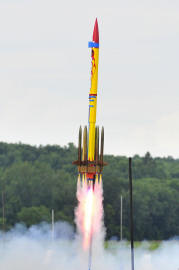
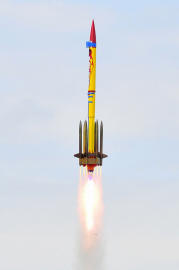
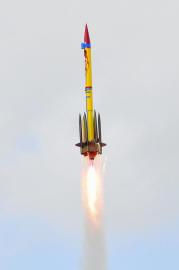

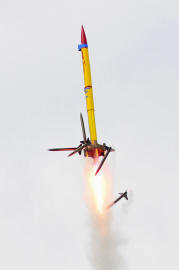

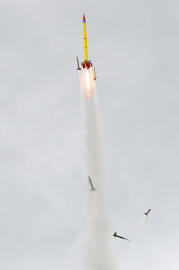


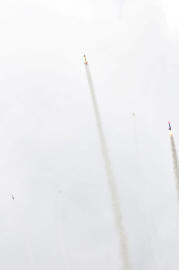
great
sequence of liftoff pictures by Neil McGilvray and Todd Haring
The
Hot Rod Nitro Fireball project flew well at LDRS. Fired 18 of 19 installed
motors, using 5 different motors from 4 manufacturers:
All motors fired by Rocketflite MF ematches boosted with Rocketflite ML
pyrogen, both ejection charges were also fired by MF ematches.
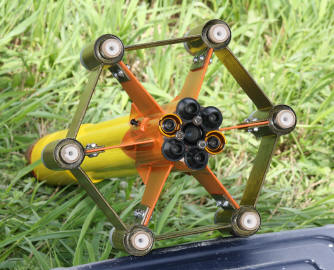 |
Stage 1:
1x AMW Pro-X 29mm H170 Blue Streak
2x AT G71 Redlines
4x Roadrunner G80-10 (smoky motors, one of these did not ignite,
usually these fire quickly)
6x Estes D11-P (at the fin tips)
The H was in the center providing the long flame tail, surrounded
by the 6x G motors pumping red and black into the flame. The BP motors
in the fin tips fed their flame into the AP fireball below the rocket
to good effect.
|
Stage 2: Were the 6x Hot Rod Rockets Nitro rockets each powered by a
D12-5.
Fired by a Perfectflite MT3G timer at 0.6 seconds. These all fired and went
in an upward direction to cool effect.
However, they appear to have been buffeted hard by turbulence from the main
rocket, and were not pointed straight up immediately after separation. We
will have to "fine tune" this part for the next attempt.
Fired stage one impulse was J powered at about 840Ns. Stage two added about
another 100Ns. The complete rocket weighed 14.0 lbs at RSO inspection.
The main rocket (AKA Ultimate FireBall) reached an altitude of 1272ft and
deployed 3ft drogue at apogee.
Second ejection charge fired at 400ft, but the main jammed, fortunately the
very soft muddy ground prevented any damage from the quick landing. |
|
flight 1: 4/29/09 CMASS Amesbury, MA Stage
1 - main rocket: 3x G77R + 4x F40W + 6x D11-P
Stage 2 - 6x Nitros: 6x D12-5 Pre-Flight Planning:
Initial flight weight 13
lbs.
At 0.6 seconds a Perfectflite MT3G timer will fire the 6x Nitro second
stages.
The Nitros have initial separation liftoff weight of 4.8 oz and are fired by
1x D12-5 each.
Thrust curves and rocket weights appear to confirm that the
second stage rockets should pull quickly away from the first stage carrier
rocket. Did not attempt to use RockSim due to project complexity.
Using the online sim at webalt.markworld.com :
Separation at 0.6 seconds occurs at
> altitude: 50ft
> acceleration: 120 lbs thrust / 10Gs
> speed: 140 mph
at 0.8 seconds
> the main rocket continues to accelerate at a gradually reducing rate
> the 6x Nitros have peak acceleration of 18+ Gs quickly pulling away from
the main rocket
Nitros use apogee streamer recovery.
Ultimate FireBall uses proven setup of apogee drogue and main at 400 ft. 
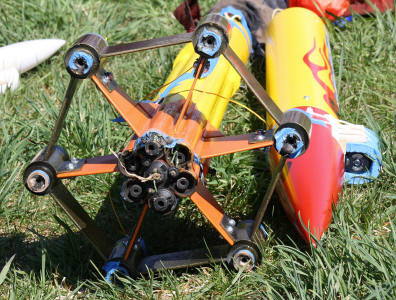
before and after flight

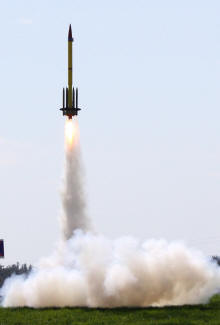
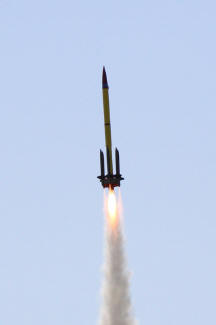
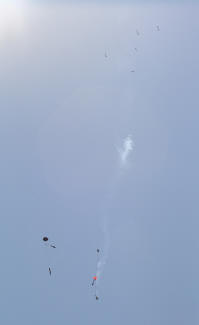
Lift off was slow on a column of fire, reaching only 484 ft.
Main rocket completed a clean recovery using deployment bag.
While the flight was safe,
three elements of the flight failed.
> Two of the G77Rs failed to light. This had a lot to do with the low
altitude. As they were both on the same series string of ematches, suspect
that part of the circuit lost continuity during the complex setup at the
pad.
> Two of the outboard D11-Ps failed to light. For the first time, tried
using wadding under tape to hold the ematches in place, but this approach
did not work well.
> The timer switch failed, so the 6x Nitros did not fire. The Nitros stayed with the main rocket until apogee
drogue deployment,
then they separated and fell to the ground. |
|
Build - Spring 2009
Click
on any picture to enlarge |

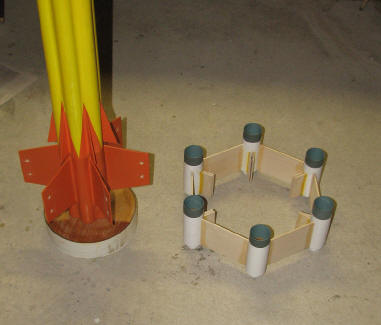
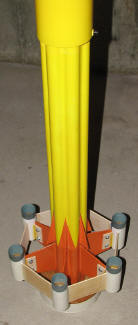
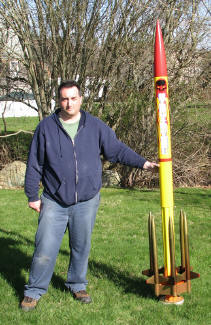
We took the 7ft tall x 4in diameter Ultimate
FireBall, built a "Ring of Fire" and screwed to the fins.
David and rocket.
Ring of Fire: 1.6" cardboard tubing
first stage pods with 1/8" plywood tabs that screw onto fins.
Joined and reinforced the tail assembly with 3" x 1/8" basswood strips just
over 4" long.
Reinforced with 3oz fiberglass and painted with epoxy internally.
Then mounted 6x
Nitro rockets to it. |

In the electronics bay: Perfectflite HA45K altimeter (to dual
deploy the main rocket) and MT3G timer (to fire the 6x Nitros). The banana
plugs will be taped to the side of the rocket, carry ignition power to the
Nitros, and later separate at apogee deployment. The dual Duracell 9V
alkalines are wired in parallel and power both devices. |
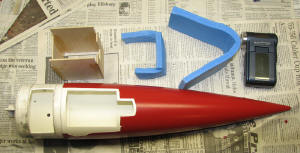

To capture onboard video:
Picked up an Aiptek GO HD video camera.
Cut out an opening in the PML 4" NC.
Cut dense foam padding to shape and made a basic wood frame from 1/8" ply.
Not pictured is 2 tie wraps and some tape that will pin it all together for
flight. |
|
































